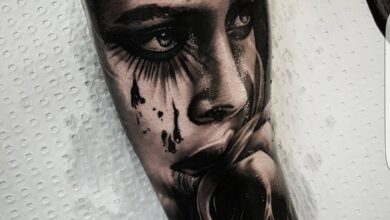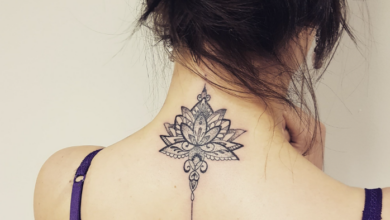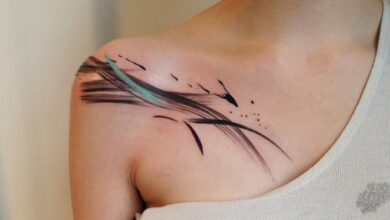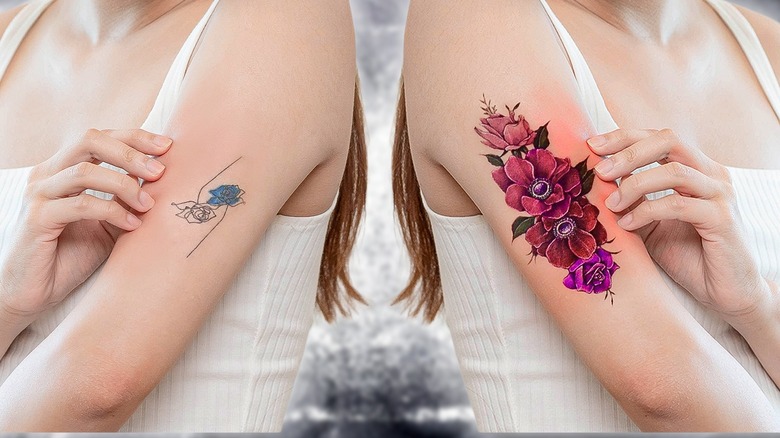
You may have regretted getting a tattoo in the past, but all hope is not lost. The fascinating world of tattoo cover-ups allows you to transform your old ink into a stunning piece of art. With the help of skilled tattoo artists and their creative abilities, you can turn that unwanted tattoo into something beautiful and meaningful. From clever designs that cleverly camouflage the old ink, to breathtaking artwork that completely transforms the original image, the possibilities are endless. Say goodbye to tattoo regrets and hello to a new and improved design that you can proudly show off.

What is a tattoo cover-up?
A tattoo cover-up is a process of creating a new design to conceal or transform an existing tattoo. It involves using various techniques and artistic skills to turn an old tattoo into a new and improved piece of art. Instead of feeling stuck with a tattoo that no longer reflects your style or belief, a cover-up provides an opportunity to refresh your body art.
Definition of a tattoo cover-up
A tattoo cover-up refers to the process of hiding or modifying an unwanted tattoo by creating a new design that is strategically placed over the existing tattoo. This technique allows individuals to transform their old tattoos into something more aesthetically pleasing or meaningful to them.
Reasons for getting a tattoo cover-up
There are several reasons why someone might opt for a tattoo cover-up. One common reason is that they no longer resonate with the original design, whether it’s due to changing tastes or personal growth. Others may have regrets about a certain tattoo, such as a name of an ex-partner or a design that no longer holds significance. Additionally, cover-ups can be chosen to enhance or modify an existing tattoo that has faded or become distorted over time.
Benefits of a tattoo cover-up
Getting a tattoo cover-up offers numerous benefits. Firstly, it allows you to reclaim your body art and feel confident in the tattoos you have. It provides an opportunity for personal expression and creativity, allowing you to have a tattoo that reflects who you are at this moment in your life. Moreover, a cover-up can be a more cost-effective option than tattoo removal, as it avoids the need for extensive laser treatments or other removal methods.

Consultation and planning
Before diving into the cover-up process, it’s crucial to have a solid plan and find the right artist who can bring your vision to life.
Finding the right artist
Finding a skilled and experienced tattoo artist who specializes in cover-ups is essential. Look for artists who have a portfolio showcasing their cover-up work, as this will give you an idea of their skills and creativity in transforming tattoos. Recommendations from friends or online tattoo forums can also help in finding the right artist for your cover-up.
Initial consultation
Once you’ve found a potential artist, schedule an initial consultation to discuss your cover-up ideas. During this meeting, you can talk about your reasons for wanting a cover-up, share any design inspirations you may have, and discuss what you hope to achieve with the new tattoo. The artist will also assess the existing tattoo’s size, color, and placement to determine the best approach for the cover-up.
Design considerations
When planning your cover-up tattoo, there are several design considerations to keep in mind. The new design should be large enough to effectively conceal the old tattoo while still maintaining its aesthetic appeal. Color choices, shading techniques, and placement are all important factors to consider in creating a cohesive and visually appealing cover-up tattoo.
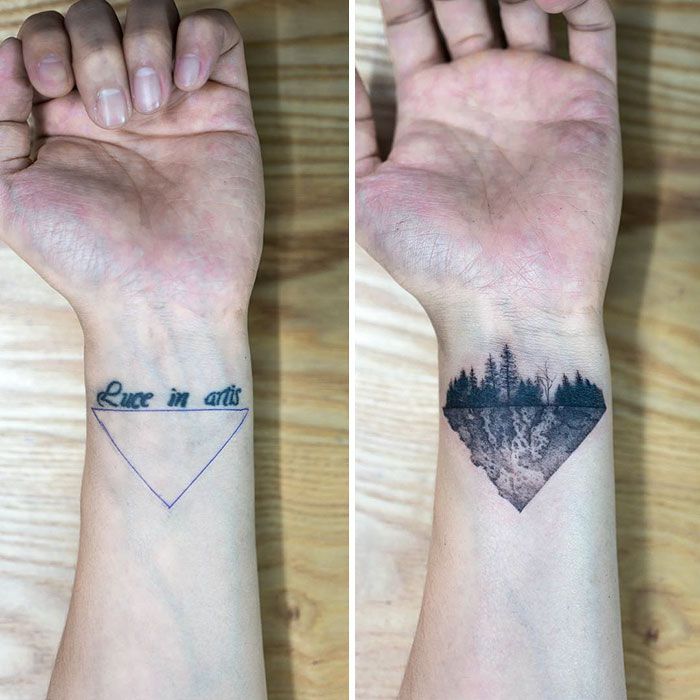
Techniques for covering up tattoos
Tattoo cover-ups require specific techniques to effectively hide or transform the old tattoo into a new design. Here are some common techniques used by tattoo artists:
Blackout tattooing
Blackout tattooing involves completely covering the existing tattoo with solid black ink. This technique can be an effective way to conceal old tattoos, especially if they’re large or have faded significantly. Blackout tattoos can create a bold and cohesive aesthetic when done by a skilled artist.
Color blending
Color blending is a technique where the new design incorporates elements of the old tattoo, blending it seamlessly with the new colors and shapes. This technique works well when the existing tattoo can be integrated into the new design, helping to create a cohesive and visually appealing cover-up.
Adding new elements
Another common technique is adding new elements to the existing tattoo to transform its appearance. For example, an artist may add additional imagery, such as flowers or animals, to distract from the original tattoo and create a new focal point. This technique allows for more creativity and customization in the cover-up process.
Distraction techniques
Distraction techniques involve diverting attention away from the old tattoo by incorporating other visually captivating elements. This could include intricate patterns, abstract designs, or incorporating negative space strategically to draw attention away from the old tattoo. Distraction techniques can be effective for covering up tattoos that are difficult to modify or incorporate into the new design.
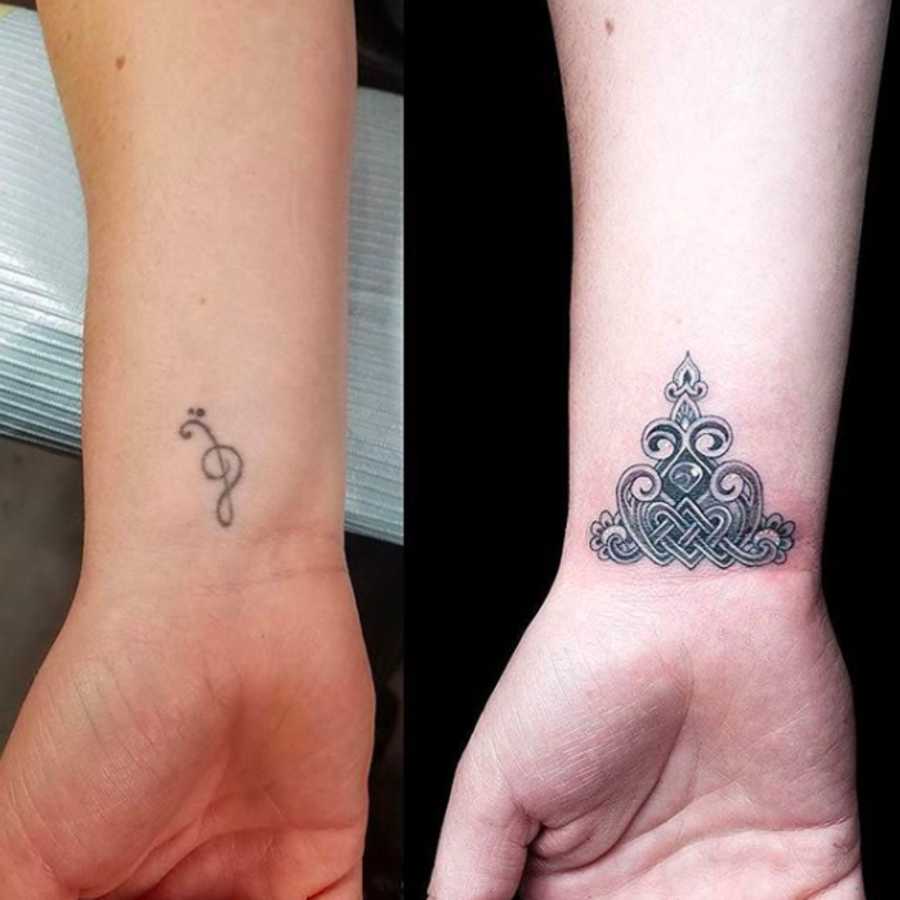
Preparing for a cover-up tattoo
Proper preparation is crucial to ensure the success of a cover-up tattoo. Consider the following factors before undergoing the cover-up process:
Skin preparation
Preparing the skin is essential to create an optimal canvas for the cover-up tattoo. It’s recommended to moisturize the skin regularly leading up to the cover-up appointment, as hydrated skin is more receptive to ink and can help the healing process. Additionally, avoiding excessive sun exposure and protecting the area with sunscreen will prevent the existing tattoo from further fading or distortion.
Tattoo fading methods
In some cases, the tattoo artist may recommend fading the existing tattoo before attempting the cover-up. This can be done through laser tattoo removal or using tattoo fading creams. Fading the tattoo helps to break down the pigments, making it easier for the artist to create a new design and ensures better overall results.
Covering dark or bold tattoos
Covering dark or bold tattoos requires careful consideration and planning. The artist may suggest lightening the tattoo with techniques like laser tattoo removal or strategically incorporating lighter colors into the new design. Communication with the artist is crucial to ensure the cover-up design effectively hides the dark or bold elements of the original tattoo.
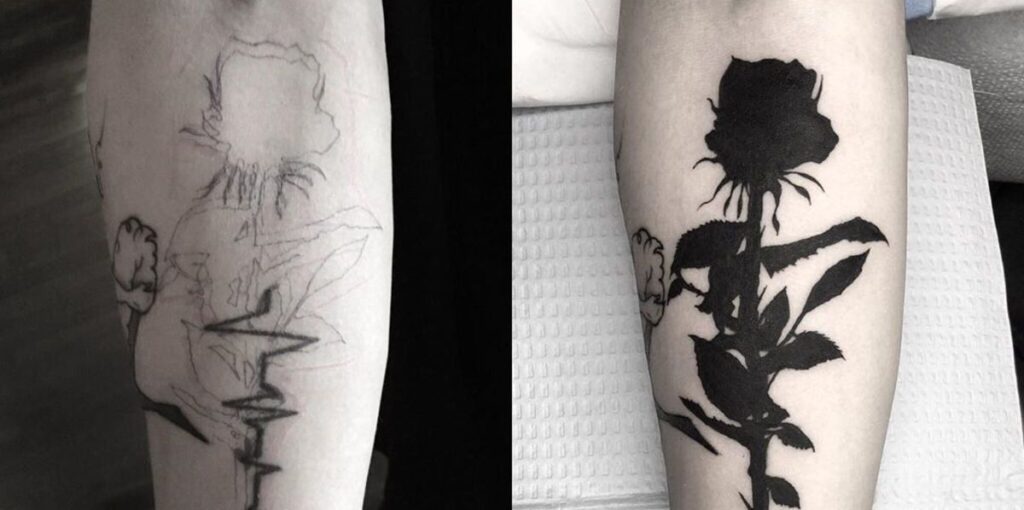
Executing the cover-up
Once the consultation and preparation stages are complete, it’s time to move forward with the actual cover-up tattoo process.
Multiple sessions
Cover-up tattoos often require multiple sessions to achieve the desired results. This allows the artist to layer colors, blend shades, and ensure proper coverage. The number of sessions will vary depending on the size, complexity, and colors involved in the cover-up. It’s important to be patient and trust the process to achieve the best outcome.
Pain and discomfort
Similar to getting any tattoo, the cover-up process may involve some degree of pain or discomfort. However, the level of discomfort can vary depending on the location of the tattoo and individual pain tolerance. Tattoo artists can use numbing creams or other techniques to minimize discomfort during the process.
Healing process
After each session, proper care of the cover-up tattoo is essential for optimal healing and long-term results. The artist will provide specific aftercare instructions, which typically include cleaning the tattoo gently, applying a thin layer of tattoo aftercare ointment, and avoiding activities that may irritate or damage the tattoo during the healing period. Following the aftercare instructions diligently will ensure the tattoo heals properly and retains its vibrancy.
Aftercare and maintenance
Once the cover-up tattoo has healed, proper aftercare and maintenance are crucial for its long-term appearance and longevity.
Proper cleaning and moisturizing
Regular cleaning and moisturizing of the tattooed area will help keep the skin healthy and the tattoo vibrant. Use a mild, fragrance-free soap to cleanse the tattoo gently, followed by a tattoo-friendly moisturizer to keep the skin hydrated. Avoid picking or scratching the tattoo, as it can lead to scarring or color loss.
Avoiding sun exposure
Exposing the cover-up tattoo to excessive sunlight can cause fading and damage to the colors over time. It’s important to protect the tattooed area from prolonged sun exposure by wearing clothing that covers it or applying a high SPF sunscreen. UV rays can break down the pigments in the tattoo, leading to a dull and faded appearance.
Touch-up sessions
Over time, tattoos may experience slight fading or areas that require touch-ups. It’s common for tattoo artists to offer touch-up sessions as part of their service. These sessions allow the artist to address any areas that may have faded or require additional shading, ensuring the longevity and vibrancy of the cover-up tattoo.
Showcasing successful cover-up stories
Seeing before and after transformations can be inspiring for those considering a tattoo cover-up. Several success stories showcase how cover-ups have transformed unwanted tattoos into creative and meaningful designs.
Before and after transformations
Before and after photos provide a visual representation of the remarkable transformations achieved through cover-up tattoos. They highlight the artistic skills of the tattoo artist and demonstrate the potential to turn an unwanted tattoo into a beautiful piece of art that the wearer is proud to display.
Inspiration from popular cover-up artists
Drawing inspiration from popular cover-up artists can help generate ideas and find a style that resonates with your preferences. Examine the work of renowned cover-up artists, both locally and internationally, to see their creative solutions and execution. Social media platforms like Instagram can serve as a valuable resource for finding artists who specialize in cover-up tattoos.
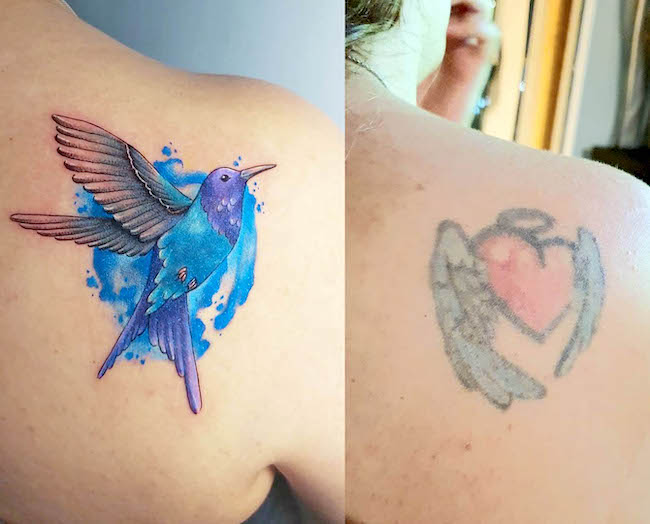
Cover-up tattoo design ideas
Cover-up tattoos offer endless possibilities for new and exciting designs. Here are a few popular design ideas to consider:
Floral cover-ups
Incorporating intricate flowers and botanical elements into a cover-up tattoo can provide a fresh and vibrant look. Floral designs can effectively conceal existing tattoos and add a touch of elegance and beauty to the overall composition.
Geometric patterns
Geometric patterns and shapes can help cover and transform existing tattoos, especially ones with bold lines or specific symbols. These designs offer a modern and artistic approach to cover-ups, creating a visually appealing and cohesive aesthetic.

Watercolor effects
Watercolor-inspired tattoos provide a unique and artistic way to cover-up old tattoos. The soft and blended colors in watercolor tattoos can help conceal or blend the original tattoo seamlessly, creating a beautiful and abstract piece of body art.
Incorporating nature elements
Using elements from nature, such as landscapes, animals, or natural textures, can help create a captivating cover-up design. By incorporating these elements strategically, the old tattoo can become part of a larger, more meaningful composition that reflects the wearer’s connection to nature.
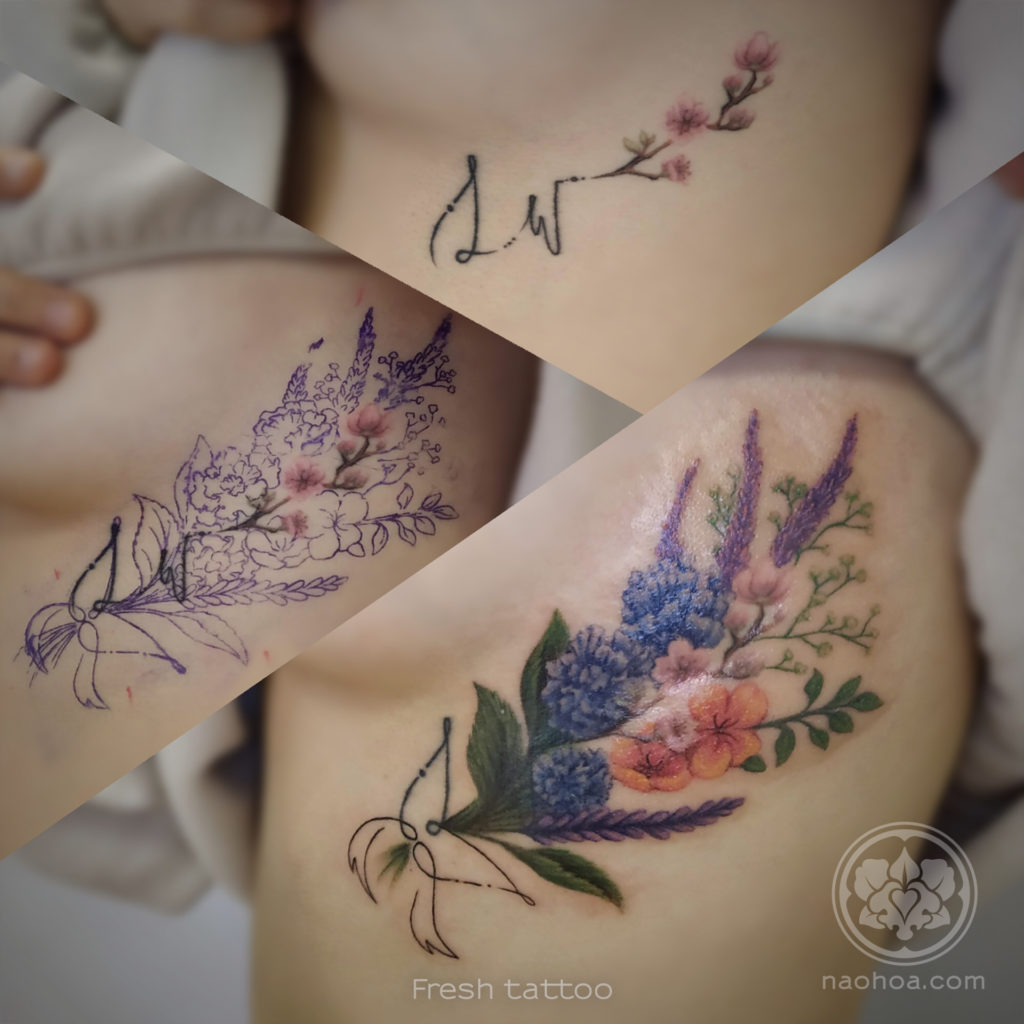
Considering tattoo removal instead
While cover-up tattoos can be a fantastic option for many individuals, it’s worth considering tattoo removal methods if you’re determined to get rid of an unwanted tattoo entirely.
Laser tattoo removal
Laser tattoo removal is a popular method for eliminating unwanted tattoos completely. It involves using laser technology to break down the ink particles in the tattoo, allowing the body to naturally eliminate them over time. Laser tattoo removal requires multiple sessions and can be quite costly, depending on the size and colors involved in the tattoo.
Other tattoo removal methods
Besides laser tattoo removal, other methods include surgical excision, dermabrasion, and chemical peels. These methods are typically more invasive and may result in scarring or other complications. Consultation with a dermatologist or tattoo removal specialist is essential to determine the most suitable method based on the tattoo’s size, colors, and location.
Conclusion
Tattoo cover-ups offer an opportunity to transform old tattoos into new works of art that better reflect your current style and preferences. Through consultation, planning, and skilled artistic techniques, tattoo artists can effectively hide or modify existing tattoos, creating stunning cover-ups that provide a fresh and renewed sense of self-expression. Whether you choose to cover up your tattoo or explore tattoo removal methods, remember to prioritize your own satisfaction and find a solution that best suits your desires and personal journey in the world of body art.

